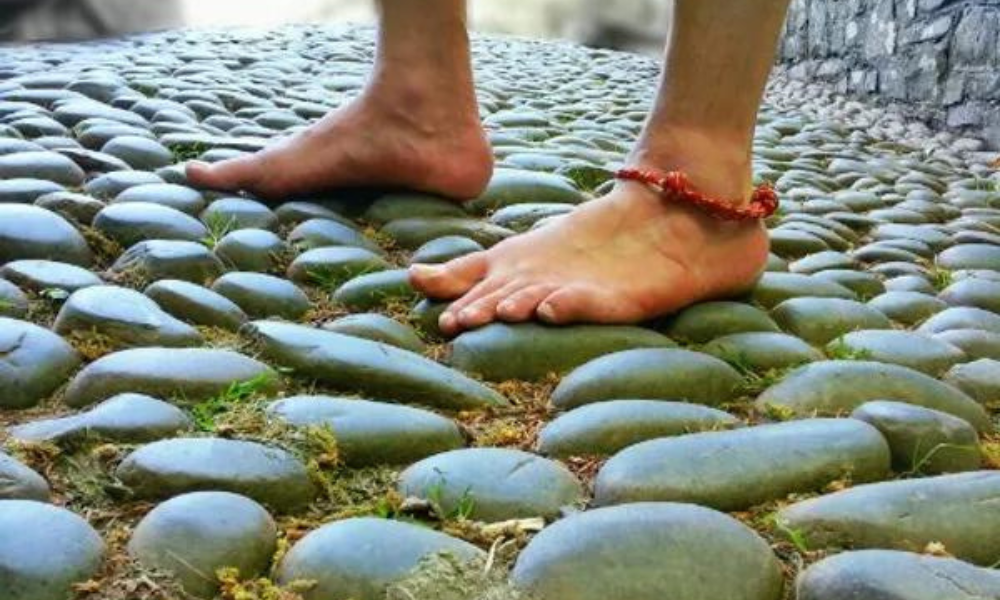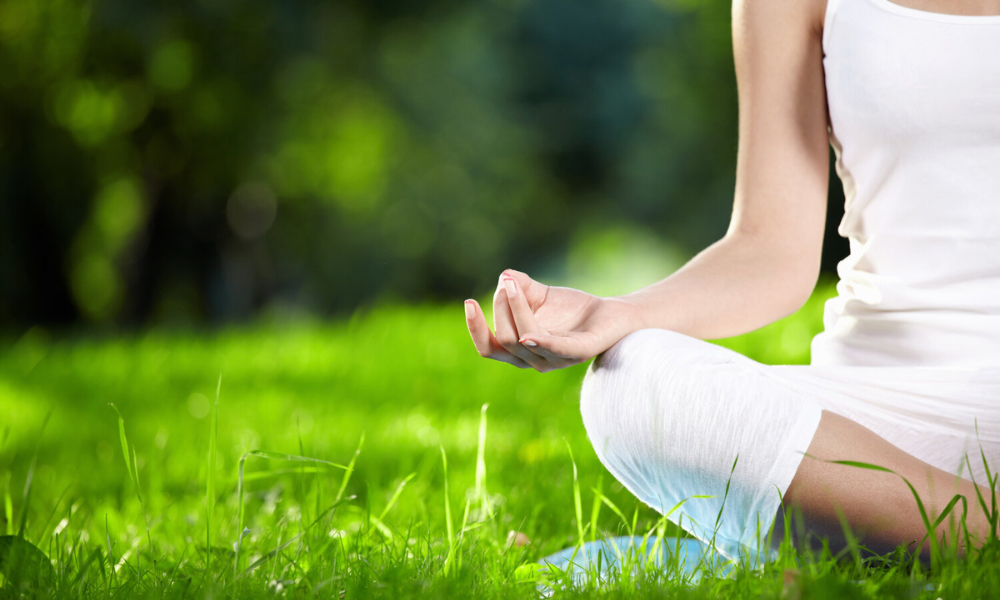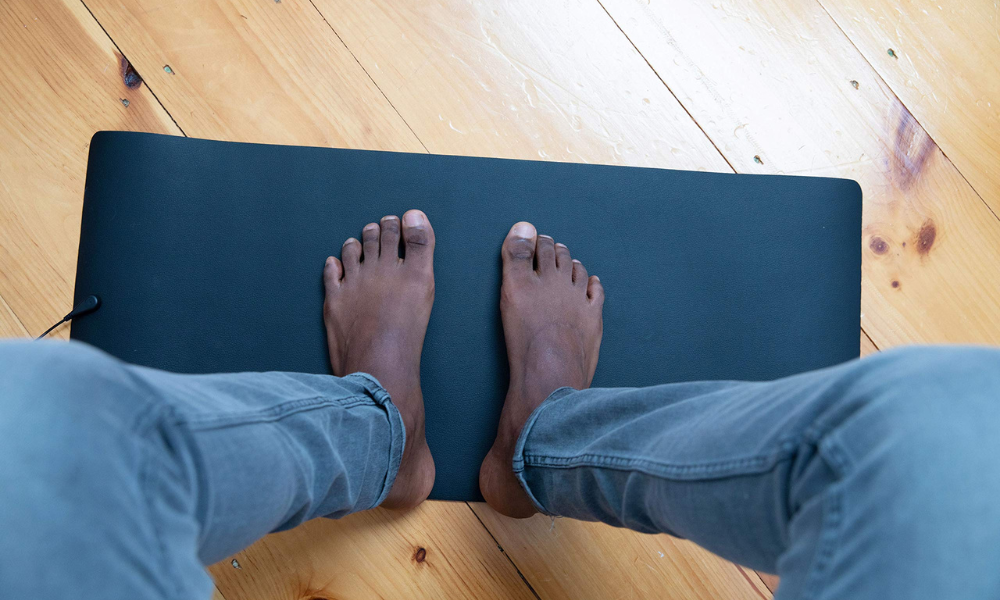In our fast-paced modernworld, it's easy to lose touch with the healing power of nature. But what if there was a simple practice that could help us reconnect with the Earth and improve our overall health and well-being?
Enter grounding, also known as earthing – a practice that has gained popularity in recent years due to its potential benefits. In this article, we'll explore what grounding is, its historical roots, scientific evidence supporting its effectiveness, practical tips for grounding yourself, recommended duration, and how it can positively mpact your body and overall health.

What is Grounding or Earthing?
Grounding, or earthing, involves connecting your body directly to the Earth's natural surface, such as soil, grass, sand, or even concrete, without the barrier of shoes or other insulating materials. This connection allows us to absorb the Earth's free electrons, which are believed to have numerous health benefits.
When asked, 'how long should you do grounding?', the answer varies. However, the recommended duration for grounding sessions is at least 20 minutes per session. Longer sessions may provide more profound effects.
It's important to remember that the impact of grounding can vary from person to person, and it may take several weeks or months to fully reap its benefits.
Historical Roots and Scientific Evidence
The concept of grounding has been around for centuries, with historical records indicating its use in ancient civilizations like Ayurveda and Traditional Chinese Medicine. However, it wasn't until the late 20th century that the scientific community began to explore its potential benefits.

Scientific studies have shown promising results in support of grounding's effectiveness. Research suggests that direct contact with the Earth's surface can have positive effects on reducing inflammation, improving sleep quality, reducing stress levels, normalizing cortisol secretion, and promoting cardiovascular health.
These findings are attributed to the transfer of electrons from the Earth to the body, which neutralizes free radicals and reduces oxidative stress in healthy tissues.
Practical Tips for Grounding
1. Choose the right surface: Find a natural surface like grass, soil, sand, or even a park bench made of wood to connect with the Earth's energy. Surfaces like asphalt and concrete can also be used, although they are less conductive.
2. Remove insulating materials: Kick off your shoes and socks to establish direct contact between your skin and the Earth's surface. This allows for effective electron transfer.

Grounding Techniques:
a. Walking barefoot: Take a leisurely walk on a natural surface walk barefoot, feeling the grass or sand beneath your feet. Allow yourself to connect with nature as you absorb the Earth's energy.
b. Grounding mats and sheets: If walking barefoot is not feasible, consider using grounding mats or sheets that can be placed on your bed or floor. These products are designed to mimic the effects of direct contact with the Earth.
Best Times to Practice Grounding
While grounding can be done at any time, certain moments may enhance its benefits. Consider the following:
1. Mornings: Start your day by grounding yourself. It can help set a positive tone for the day ahead and boost your energy levels.
2. After outdoor activities: After engaging in physical activities like jogging or hiking, take a few moments to ground yourself, allowing your body to recover and recharge.

Recommended Duration
The duration of grounding sessions can vary depending on individual needs and available time. Experts suggest starting with at least 20 minutes per session to experience noticeable benefits.
However, longer sessions, such as 30 minutes to an hour, can provide even more profound effects. Gradually increase the duration as you become more comfortable with the practice.
Factors to consider when determining the best duration include personal preferences, individual health conditions, and the availability of suitable grounding surfaces.
Benefits of Grounding

Grounding has been shown to help regulate the autonomic nervous system, and is believed to offer a range of benefits, including:
1. Reduced inflammation and pain
2. Improved sleep quality
3. Increased energy levels
4. Enhanced mood and reduction in stress levels
5. Improved blood circulation and cardiovascular health
Grounding FAQ's
As you now know, grounding, also known as earthing, is an ancient practice that is gaining increasing attention in the wellness world. It involves connecting to the earth's energy and is believed to offer a multitude of benefits, such as reducing inflammation, improving sleep, and enhancing mood.
However, given the plethora of grounding methods available, it can be challenging to determine the most suitable one for you. Many have asked how long earthing should I engage in?
To help you gain a comprehensive understanding of this age-old practice and select the optimal method, we have compiled a list of frequently asked questions about grounding.
How long until I see results from grounding?
The impact of grounding can vary from person to person, with a distinct influence on individual well-being. Physical health holds significant importance, with chronic ailments often treated more swiftly than less severe conditions such as insomnia.
Grounding triggers a diverse range of responses, leading to varying outcomes. The more we engage in exercise, the greater our improvement becomes. Grounding exists as a continuum, akin to filling up a gas tank. While the effects of grounding can be felt almost immediately, it may take several weeks or months to fully reap its benefits.
Initially, most individuals experience a sense of calm and relaxation within minutes of grounding. This tranquility is often followed by enhanced sleep, decreased stress and cortisol levels, and an overall improvement in health.
Moreover, grounding aids in reducing inflammation, improving circulation, boosting energy levels, and promoting healthier skin.
What are some examples of grounding?
When you come into direct skin contact with an object or touch it, you become grounded. This article explains how Earth resembles a massive lithium battery in this aspect. This electrical conductivity is believed to rejuvenate the body's defense mechanisms, including immune functions.
Just imagine if Earth could truly recharge a person's body battery through direct contact. The feet act as the conductive elements of the body. Walking barefoot is a delightful experience, and even experimenting with grounding shoes can be beneficial.
Engaging in grounding techniques like walking barefoot on grass or sand, swimming in the ocean, gardening, or simply lying on the ground can have profound effects.
Other forms of grounding include using an Earthing sheet, mat, or pad while sleeping, or practicing yoga outdoors. Grounding can help reduce inflammation, improve sleep quality, alleviate stress, and restore balance to the body's energy.
What are the effects on pain and the immune system response?
Research has shown that grounding can effectively reduce inflammation, uplift mood, alleviate stress, and improve sleep quality.
Moreover, grounding has been found to lower the production of cortisol, a hormone associated with stress and chronic inflammation, while increasing the production of nitric oxide, which aids in inflammation reduction and blood flow improvement.
Furthermore, grounding has been shown to enhance the body's ability to combat infections by increasing the number of white blood cells.
A pilot study was conducted to explore the use of ground-based exercises in managing delayed-onset muscle pain (DOMS). DOMS refers to the stiffness and weakness experienced in muscles after intense and prolonged workouts. Fitness and sport physiologists have undertaken various studies using the DOMS model.
Those affected by DOMS experience temporary muscle pain as a result of eccentric exercise, which involves the contraction of muscles while lengthening, such as when lowering a dumbbell.
Is it true that grounding has no health benefits?
Earthing, supported by an increasing body of research, offers a multitude of health benefits. It can enhance heart health by improving cardiovascular function and circulation, which in turn promotes better overall well-being.
Additionally, earthing has been found to alleviate inflammation, a common underlying factor in many chronic diseases, as well as help reduce symptoms of chronic disease, depression and sleep disorders.
The absence of direct contact with the Earth not only leads to physical discomfort but also impacts psychological well-being. Grounding, on the other hand, has shown promising potential in providing a holistic solution to various health concerns.
Contrary to the notion that grounding lacks many health benefits and advantages, numerous studies have demonstrated its efficacy in improving overall health and well-being.
While further research is necessary to comprehensively comprehend its effects, grounding holds promising potential for improving overall health and well-being.
Embracing the practice of earthing can empower individuals to take charge of their health and explore natural approaches to wellness.
What are the results of grounding mat?
Grounding mats are specifically designed to mitigate the effects of electromagnetic radiation on the body. They function by creating a low-resistance pathway to the Earth, allowing the body to discharge any accumulated electrical charge.
Research has also shown that grounding mats can alleviate pain, enhance circulation, and alleviate fatigue.
In a study, it was found that 85% of participants who woke up less frequently during the night reported improvement, compared to only 12% in the control group. Furthermore, 90% of participants reported experiencing better sleep quality.
Additionally, 80% of participants noticed reduced muscular stiffness muscle soreness and discomfort, while 74% reported improvement in chronic back pain.
Moreover, grounding mats can potentially minimize the impact of electromagnetic fields (EMF) on the body, which can have detrimental effects on overall health. Athletes can also benefit from grounding mats as they may help reduce muscle fatigue and expedite recovery time.
What is the best time of day to ground yourself?
When your bare feet make contact with the earth, your body experiences numerous health benefits. It is highly recommended to ground yourself before getting a good night's sleep.
If you have access to a park or any open space, you can easily practice grounding by walking barefoot.
The morning is the ideal time to ground yourself as it sets a positive tone for the rest of the day, helping you stay centered and grounded. This practice allows you to cultivate a positive mindset and prepare yourself to face any challenges that may arise.
Morning grounding activities can include meditation, yoga, walking, or simply taking a few moments to be fully present and mindful in the present moment.
It seems like more practice means more benefits.
Grounding benefits for the soul can include greater clarity, peace, and connection to the present moment. Grounding can help to reduce stress and anxiety, boost energy levels, improve sleep, and help to cultivate feelings of inner peace and balance. It can also help to reduce mental chatter, increase mental focus, and enhance creativity.
Additionally, grounding can help to foster feelings of connectedness to the natural world around you and to the spiritual aspects of life.
Are there negative side effects of grounding therapy?
Grounding has been generally proven to be safe with no adverse side effects. However, some individuals may experience mild skin irritation or a tingling sensation in their feet when first starting to ground. These sensations are typically mild and temporary and can be alleviated by wearing shoes or socks while grounding.
Furthermore, some individuals may experience increased energy levels after grounding, which may affect their ability to sleep. In such cases, it is recommended to limit the duration of grounding or avoid grounding late in the day.
While grounding or earthing may seem overwhelming at first, especially for those without a direct connection to the Earth's natural energy, many have experienced a gradual decrease in fatigue and the potential for adverse effects over time.
How often can you use a grounding mat?
Grounding mats can be used as frequently as desired, offering a multitude of benefits. To fully experience the advantages, it is recommended to incorporate at least 30 minutes of daily usage.
However, some individuals find that multiple sessions throughout the day contribute to a heightened sense of relaxation and energy. The duration of each session is entirely at the discretion of the user. Prior to use, it is vital to ensure the grounding mat is clean and free from any debris, guaranteeing an optimal experience.
Recommended Products
If you're interested in exploring grounding further, there are various products available to facilitate the practice. Some recommended options include grounding mats, sheets, wristbands, and even footwear designed with conductive soles.

Final Thoughts
In a world full of distractions and disconnection from nature, grounding offers a simple yet powerful way to reconnect with the Earth's energy and prioritize our well-being.
By incorporating grounding practices into our daily lives, we may experience a range of health benefits, from reduced inflammation to improved sleep quality. So, kick off your shoes, find a patch of grass, and allow yourself to become one with nature – your body will thank you.
References
PubMed Central - "Earthing: Health Implications of Reconnecting the Human Body to the Earth's Surface Electrons" https://www.ncbi.nlm.nih.gov/pmc/articles/PMC3265077/
ScienceDirect - "Integrative and lifestyle medicine strategies should include Earthing (grounding): Review of research evidence and clinical observations" https://www.sciencedirect.com/science/article/pii/S1550830719305476
Chopra - "Grounding the Human Body: The Healing Benefits of Earthing" https://chopra.com/articles/grounding-the-human-body-the-healing-benefits-of-earthing
DoctorKiltz - "Earthing and Grounding: Science, Benefits, How to" https://www.doctorkiltz.com/earthing-grounding/








